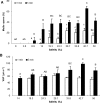pH controls spermatozoa motility in the Pacific oyster (Crassostrea gigas)
- PMID: 29483075
- PMCID: PMC5898264
- DOI: 10.1242/bio.031427
pH controls spermatozoa motility in the Pacific oyster (Crassostrea gigas)
Abstract
Investigating the roles of chemical factors stimulating and inhibiting sperm motility is required to understand the mechanisms of spermatozoa movement. In this study, we described the composition of the seminal fluid (osmotic pressure, pH, and ions) and investigated the roles of these factors and salinity in initiating spermatozoa movement in the Pacific oyster, Crassostrea gigas The acidic pH of the gonad (5.82±0.22) maintained sperm in the quiescent stage and initiation of flagellar movement was triggered by a sudden increase of spermatozoa external pH (pHe) when released in seawater (SW). At pH 6.4, percentage of motile spermatozoa was three times higher when they were activated in SW containing 30 mM NH4Cl, which alkalinizes internal pH (pHi) of spermatozoa, compared to NH4Cl-free SW, revealing the role of pHi in triggering sperm movement. Percentage of motile spermatozoa activated in Na+-free artificial seawater (ASW) was highly reduced compared to ASW, suggesting that change of pHi triggering sperm motility was mediated by a Na+/H+ exchanger. Motility and swimming speed were highest in salinities between 33.8 and 42.7‰ (within a range of 0 to 50 ‰), and pH values above 7.5 (within a range of 4.5 to 9.5).
Keywords: Ions; Motility; Salinity; Seminal fluid; Spermatozoa; pH.
© 2018. Published by The Company of Biologists Ltd.
Conflict of interest statement
Competing interestsThe authors declare no competing or financial interests.
Figures




Similar articles
-
Regulation of sperm motility in Eastern oyster (Crassostrea virginica) spawning naturally in seawater with low salinity.PLoS One. 2021 Mar 18;16(3):e0243569. doi: 10.1371/journal.pone.0243569. eCollection 2021. PLoS One. 2021. PMID: 33735238 Free PMC article.
-
Roles of extracellular ions and pH in 5-HT-induced sperm motility in marine bivalve.Reproduction. 2014 Feb 3;147(3):331-45. doi: 10.1530/REP-13-0418. Print 2014 Mar. Reproduction. 2014. PMID: 24398874
-
Involvement of Mitochondrial Activity and OXPHOS in ATP Synthesis During the Motility Phase of Spermatozoa in the Pacific Oyster, Crassostrea gigas.Biol Reprod. 2015 Nov;93(5):118. doi: 10.1095/biolreprod.115.128538. Epub 2015 Sep 30. Biol Reprod. 2015. PMID: 26423125
-
Role of the ionic environment and internal pH on sperm activity.Hum Reprod. 1998 Dec;13 Suppl 4:20-30. doi: 10.1093/humrep/13.suppl_4.20. Hum Reprod. 1998. PMID: 10091055 Review.
-
Sperm motility in fishes. (II) Effects of ions and osmolality: a review.Cell Biol Int. 2006 Jan;30(1):1-14. doi: 10.1016/j.cellbi.2005.06.004. Epub 2005 Nov 8. Cell Biol Int. 2006. PMID: 16278089 Review.
Cited by
-
Regulation of sperm motility in Eastern oyster (Crassostrea virginica) spawning naturally in seawater with low salinity.PLoS One. 2021 Mar 18;16(3):e0243569. doi: 10.1371/journal.pone.0243569. eCollection 2021. PLoS One. 2021. PMID: 33735238 Free PMC article.
-
Decreasing pH impairs sexual reproduction in a Mediterranean coral transplanted at a CO2 vent.Limnol Oceanogr. 2021 Nov;66(11):3990-4000. doi: 10.1002/lno.11937. Epub 2021 Sep 25. Limnol Oceanogr. 2021. PMID: 35873528 Free PMC article.
-
Effects of Ammonia Concentration on Sperm Vitality, Motility Rates, and Morphology in Three Marine Bivalve Species: A Comparative Study of the Noble Scallop Mimachlamys nobilis, Chinese Pearl Oyster Pinctada fucata martensii, and Small Rock Oyster Saccostrea mordax.Biology (Basel). 2024 Aug 3;13(8):589. doi: 10.3390/biology13080589. Biology (Basel). 2024. PMID: 39194527 Free PMC article.
-
Microbiomes of the Sydney Rock Oyster are acquired through both vertical and horizontal transmission.Anim Microbiome. 2022 May 19;4(1):32. doi: 10.1186/s42523-022-00186-9. Anim Microbiome. 2022. PMID: 35590396 Free PMC article.
-
Osmoregulation in fish sperm.Fish Physiol Biochem. 2021 Jun;47(3):785-795. doi: 10.1007/s10695-021-00958-1. Epub 2021 Jun 2. Fish Physiol Biochem. 2021. PMID: 34076793 Review.
References
LinkOut - more resources
Full Text Sources
Other Literature Sources

